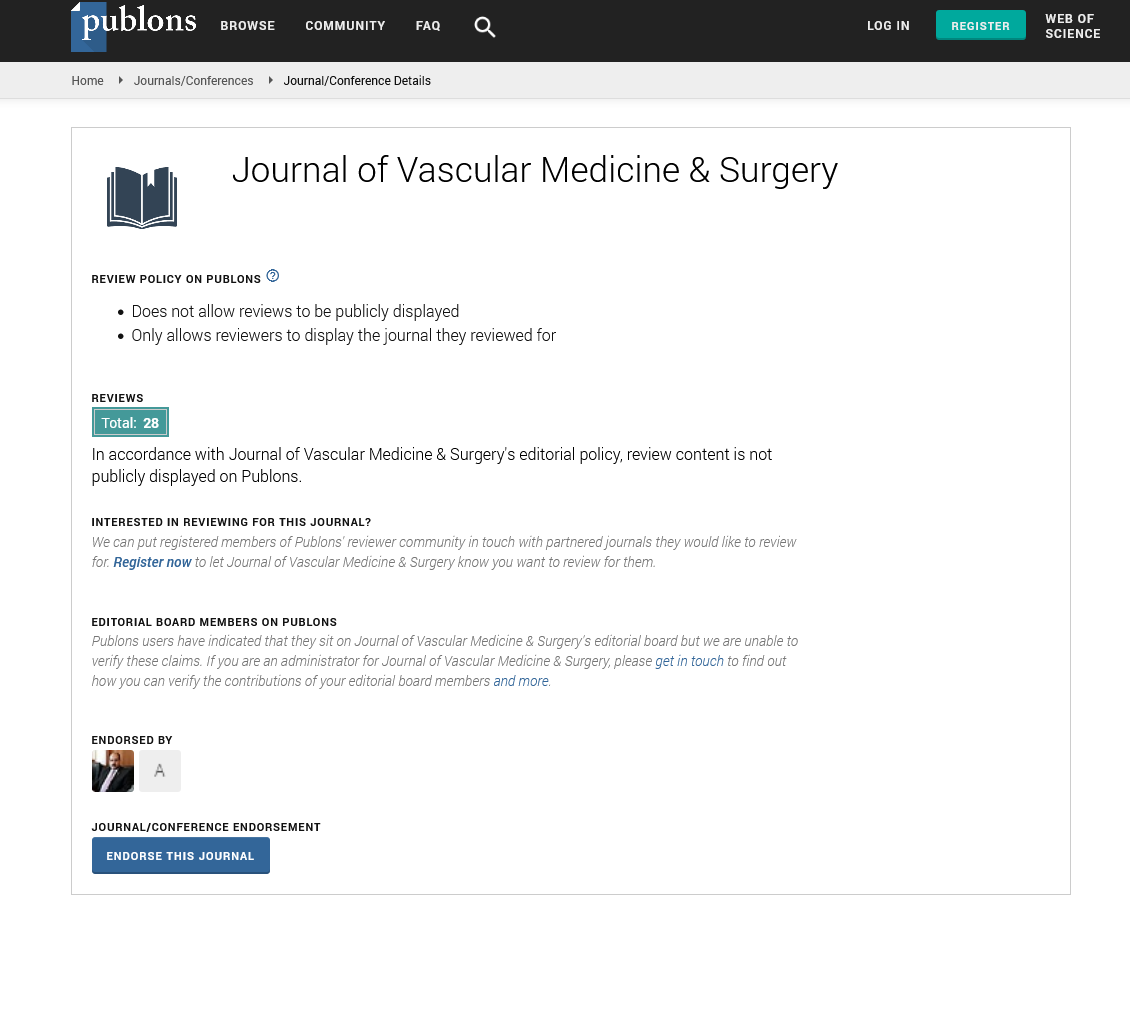Indexed In
- Open J Gate
- Academic Keys
- RefSeek
- Hamdard University
- EBSCO A-Z
- OCLC- WorldCat
- Publons
- Euro Pub
- Google Scholar
- SHERPA ROMEO
Useful Links
Share This Page
Journal Flyer

Open Access Journals
- Agri and Aquaculture
- Biochemistry
- Bioinformatics & Systems Biology
- Business & Management
- Chemistry
- Clinical Sciences
- Engineering
- Food & Nutrition
- General Science
- Genetics & Molecular Biology
- Immunology & Microbiology
- Medical Sciences
- Neuroscience & Psychology
- Nursing & Health Care
- Pharmaceutical Sciences
Perspective - (2025) Volume 13, Issue 3
The Evolution of EVAR: Balancing Innovation with Long-term Outcomes
Min Cheng*Received: 28-Feb-2025, Manuscript No. JVMS-25-28762; Editor assigned: 03-Mar-2025, Pre QC No. JVMS-25-28762 (PQ); Reviewed: 17-Mar-2025, QC No. JVMS-25-28762; Revised: 24-Mar-2025, Manuscript No. JVMS-25-28762 (R); Published: 31-Mar-2025, DOI: 10.35248/2329-6925.25.13.589
Description
The landscape of Abdominal Aortic Aneurysm (AAA) repair has undergone dramatic transformation since the introduction of Endovascular Aneurysm Repair (EVAR) in the early 1990s. What began as an experimental approach has evolved into the predominant treatment modality for AAA, with over 70% of elective repairs now performed endovascularly in most developed healthcare systems. This shift represents one of vascular surgery's most profound paradigm changes, yet the maturation of long-term data necessitates a nuanced reassessment of EVAR's role in contemporary practice.
The initial enthusiasm for EVAR was well-founded. Early randomized controlled trials demonstrated clear perioperative benefits with significantly reduced 30-day mortality, decreased blood loss, shorter hospital stays, and improved early quality of life compared to open surgical repair. These advantages propelled rapid adoption, technological advancement, and expanded indications. However, time has revealed a more complex picture that demands careful consideration.
Long-term follow-up from pivotal trials including EVAR-1, DREAM, OVER, and ACE has consistently demonstrated convergence of mortality curves between EVAR and open repair, typically within 3-5 years. More concerning has been the documentation of higher rates of late rupture, increased need for reintervention, and persistent aneurysm-related mortality in EVAR cohorts. The EVAR-1 trial's 15-year data revealed that the early survival advantage was completely lost and eventually reversed, with a higher overall mortality in the EVAR group. These findings have prompted legitimate questions about the durability and long-term efficacy of endovascular approaches.
Additionally, the evolution of device technology has created a complex landscape of generational changes that complicate outcome assessment. Contemporary devices bear little resemblance to those used in the landmark trials that form much of our evidence base. Modern stent-grafts feature lower-profile delivery systems, active fixation mechanisms, improved conformability, and better seal zone technologies. Whether these advancements translate to improved long-term outcomes remains incompletely understood, as rigorous comparative data between device generations are sparse.
The economic implications of EVAR also merit consideration. While the procedure itself may carry cost advantages related to shorter hospitalization and decreased perioperative complications, the cumulative expense of lifelong surveillance and potential reinterventions creates a different calculus. Health economic analyses suggest that the total system cost of EVAR exceeds open repair when considering the complete patient journey, raising questions about resource allocation and value-based care in an increasingly constrained healthcare environment.
Perhaps most critically, the broadening indications for EVAR have resulted in its application in anatomies and patient populations that fall outside the manufacturer's Instructions For Use (IFU). Multiple registry analyses demonstrate that 30–60% of EVARs are performed outside IFU guidelines, with correspondingly higher rates of type I endoleaks, migration, and reintervention. This trend toward "indication creep" reflects the technical success and lower perioperative risk of modern devices but may contribute to diminished long-term outcomes.
The path forward requires a recalibration of our approach to AAA management. Rather than viewing EVAR and open repair as competing alternatives, we must conceptualize them as complementary options within a comprehensive treatment paradigm. Anatomic suitability, life expectancy, physiologic status, and patient preference should guide individualized decision-making. For younger patients with reasonable surgical risk and long life expectancy, the durability advantages of open repair may outweigh the perioperative benefits of EVAR. Conversely, older patients with limited life expectancy may derive maximal benefit from EVAR's reduced perioperative morbidity.
Conclusion
Furthermore, we must commit to rigorous surveillance protocols and timely reintervention when indicated for EVAR patients. The failure to maintain vigilant follow-up negates many of the potential benefits of endovascular repair and exposes patients to the catastrophic risk of late rupture. Emerging surveillance modalities that reduce radiation exposure and nephrotoxicity while maintaining sensitivity for complications may improve compliance and outcomes. The continued evolution of EVAR technology, including fenestrated and branched devices, physician-modified grafts, and endoanchoring systems, holds promise for expanding anatomic applicability while improving durability. However, these advances must be evaluated through methodologically sound clinical trials with appropriate longterm follow-up before widespread adoption.
Citation: Cheng M (2025). The Evolution of EVAR: Balancing Innovation with Long-term Outcomes. J Vasc Surg. 13:589.
Copyright: © 2025 Cheng M. This is an open access article distributed under the terms of the Creative Commons Attribution License, which permits unrestricted use, distribution, and reproduction in any medium, provided the original author and source are credited.

